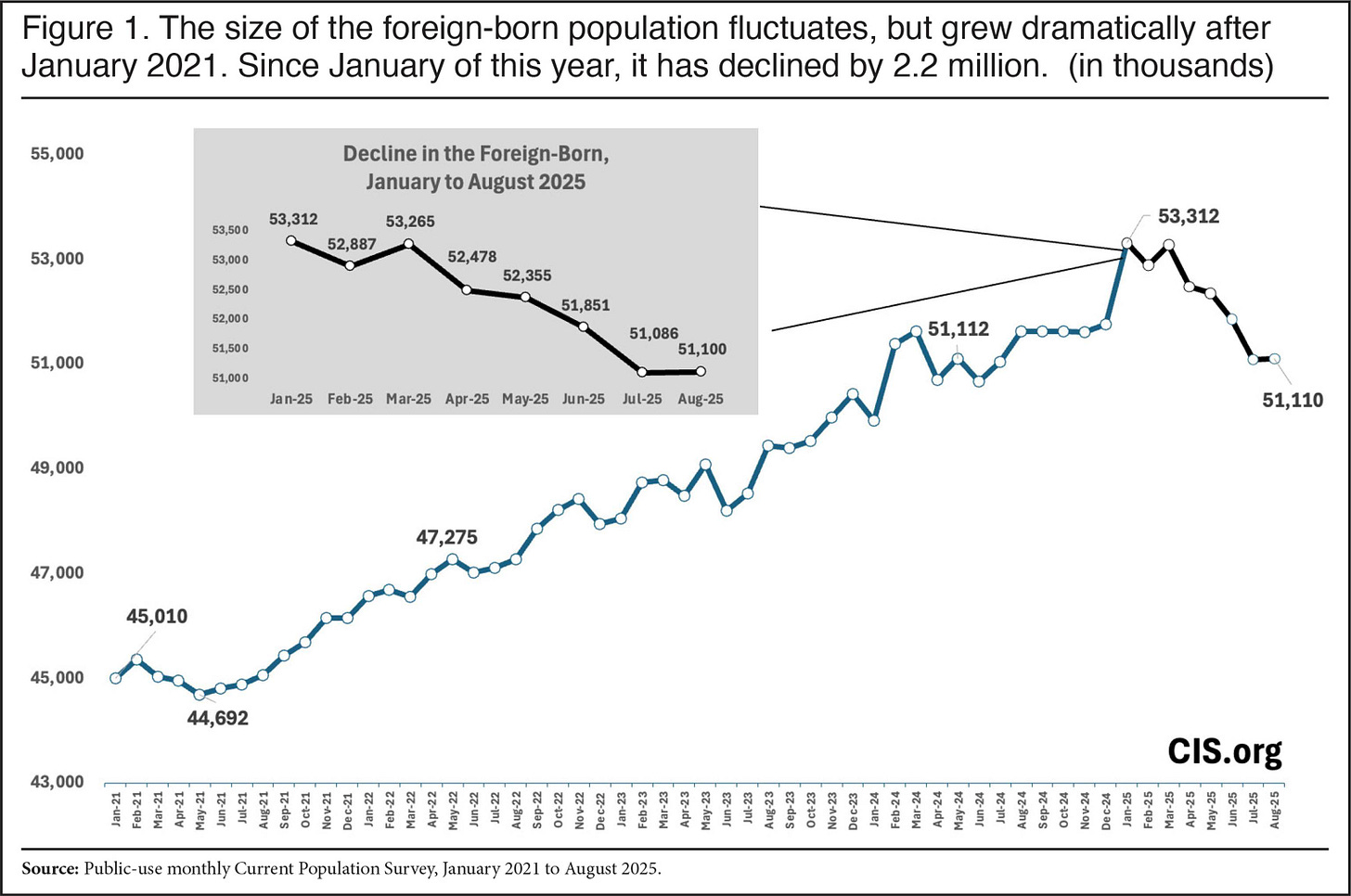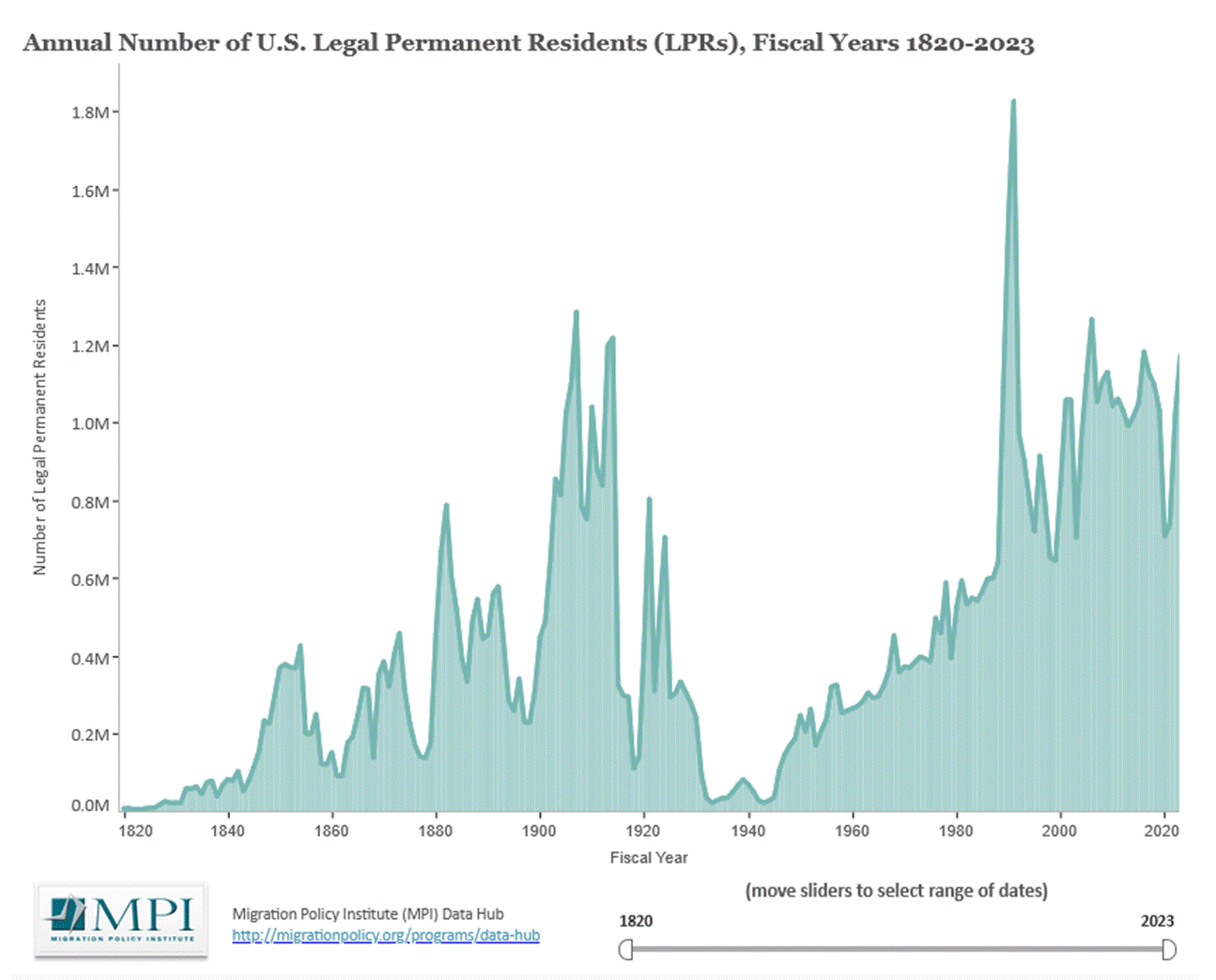Above: The failure of integration. See Riots Past And Present—The Answer Is Always “Ruthless Coercion”
The American Right has come a long way in the last few years. While Americans have always opposed illegal immigration (most people are rightly offended by videos of untold millions of people streaming across our Southern Border and vote accordingly), there was very little discontent with legal immigration.
The United States now has an administration that is deporting people by the hundreds of thousands while more than a million and a half more have self deported. The government and independent think tanks such as the Center for Immigration Studies and PEW Research Center have released data showing the foreign-born population of the United States is on the decline for the first time in 60 years.

Americans have won the battle against illegal immigration for the time being.
This victory has led many on the right to pivot to the issue of legal immigration. The “influencers” of the MAGA movement such as Matt Walsh, Jack Posobiec and right-wing politicians like Florida governor Ron DeSantis, Indiana congressman Jim Banks, Florida Congressman Randy Fine, and Georgia congresswoman Marjorie Taylor Greene have all come out strongly in favor of major legal immigration reform, including multiple calls for the denaturalization and deportation of various immigrant/immigrant populations who have failed to integrate or contribute to the American project. Considerations of cultural, religious, and even ethnic compatibility are now being discussed openly among the American right. These are fantastic developments.
The obvious question becomes, how or why did legal immigration force its way into the political arena after decades of being off limits for public debate? The short answer is that many Americans and American politicians recognize that mass immigration of all kinds, not just the illegal variety, presents a serious threat to the viability of the American Dream.
The United States has been admitting, on average, more than one million legal immigrants every year since the 1990s, with several years nearing 1.2 million admissions.

This level of mass legal immigration has led to a state of affairs where than foreign-born workers now constitute 19.2% of the American labor force, or about 32 million people. The foreign-born workforce has more than doubled from the 15.4 million foreign-born workers resident in the United States in 2000 while in the year 1990 foreign-born workers were barely 9% of the civilian labor force. The American state has created programs like the Optional Practical Training program that allows foreign-born students to work for American employers without being subject to payroll taxes, making them as much as 8% cheaper than hiring American graduates. The state has also enabled this huge immigrant population to compete with Americans for increasingly scarce housing resources. Upwards of 6% of new Federal Housing Administration (FHA) loan locks were provided to immigrants without permanent residency in the United States at the end of 2024. The Trump administration did ban this practice in May of 2025 and the rate has since fallen to below 1%.
The combination of these policies has resulted in young Americans being locked out of large parts of the job and housing market while older Americans have been forced to train their H1-B replacements before being discarded by American corporations. Legal immigration is a threat to the American Dream, and our leaders are finally coming to realize it. Now that the political class is making changes to the legal immigration system, we must pivot to the issue of second and third-generation immigrants who have failed to integrate into American society. We need to talk about remigration.
The best way to prove that integration doesn’t work is to simply take their word for it. The Pew Research Center has tracked the self-described identity of immigrants and their descendants since the year 2002 and the data speaks for itself: Hispanics have failed to integrate.
The Pew Hispanic Center/Kaiser Family Foundation 2002 National Survey of Latinos, found that 88% of Hispanics in the country preferred to use their country of their ancestors to describe themselves (Cuban, Mexican, etc) while just 53% were likely to ever use the term “American” to describe themselves. At this time, the Hispanic population was only about 39 million. This same survey found that when asked to pick a “first or only term” to identify themselves, only 21% of Hispanics chose the term “American.” Even among American-born Hispanics, the share of chose “American” was only 46%. Pew would go on to repeat this survey several times.
By 2009, when the Hispanic population reached 49 million, Pew found that 24% of young Hispanics described themselves as “Americans” first while 52% preferred their country of ancestral origin. 20% preferred the terms “Hispanic” or “Latino.” Among second-generation (American born) Hispanics, the share who identified as “American” first rose to 33%. Among third-generation Hispanics, the “America:” first share rose to 50%. This was very modest progress that appeared to hold steady when Pew ran the survey again in 2013. The 2013 data showed 23% of Hispanics most often described themselves as “American,” including 42% of American-born Hispanics. Among second-generation Hispanics, 30% identified as “American.” And among the third-generation. 59% identified most often as “American.”
These incredibly modest levels of integration have since given way to a near total collapse in integration. Between 2009 and 2024 the Hispanic population rose by another 20 million, reaching 68 million. By 2020, the Pew data showed integration had been thrown in reverse. As of 2020 only 14% of Hispanics identified as American. Just 22% of second-generation and 33% of first-generation Hispanics primarily identified as “American.” Furthermore, 44% of Hispanics said they feel “very different” from a typical American. Less detailed data from 2024 shows that identification as “American” remains low among Hispanics, at just 17%.
There was a clear reversal in national identity trends despite efforts to grant citizenship. In 2023, more than 81% of Hispanics were American citizens—a seven-point increase from 2010. It is clear that citizenship is not inspiring American identity.
Hispanics are not unique in this integration failure. Among Asians in the United States, whose population has increased from 980,000 in 1965 to 26 million as of 2024 (and a majority of whom are foreign-born), integration is not substantially better than among the Hispanic population. A 2023 Pew survey found that only 10% identify “American” and 16% identify as “Asian American.”

Only 53% of Asians overall in the United States would consider themselves to be typical Americans.
Furthermore, large shares of these populations feel such a lack of connection to the United States that many want to leave. A March 2024 Monmouth University poll found that 45% of Americans of Color would resettle in another country if “free to do so.” And a February 2025 poll by Harris polling found that 61% of Hispanics and 57% of African Americans have considered leaving the country in the next two years. Among Asians a 2023 Pew survey found that 26% of Asians, including 30% of those born abroad and 14% born in the United States, would move to their ancestral homeland.

America has never before had such large populations of culturally, ethnically, and religiously disparate foreigners; nor has this country ever attempted to integrate such a large volume of people. These populations are so large that they are able to maintain separate communities and institutions and agitate for their specific ethnic interests rather than adopting the national interests of the United States. The American people have a choice to make, and it is a serious one:
Do we attempt and forcibly integrate huge populations of immigrants and their descendants who feel little attachment to our country? Or do we admit that this experiment in multiculturalism has failed and work to send those home who have not integrated?
We feel the choice is obvious: remigration is the best outcome for everyone.
